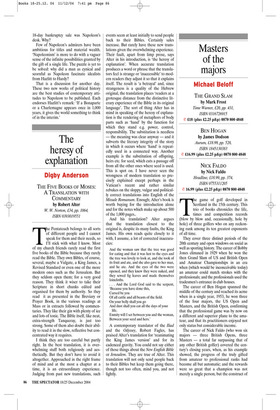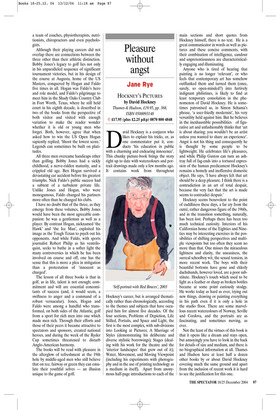Masters of the majors
Michael Beloff
THE GRAND SLAM by Mark Frost Time Warner, £20, pp. 431, ISBN 0316726915 ✆ £18 (plus £2.25 p&p) 0870 800 4848 BEN HOGAN by James Dodson Aurum, £18.99, pp. 528, ISBN 1845130383 ✆ £16.99 (plus £2.25 p&p) 0870 800 4848 NICK FALDO by Nick Faldo Headline, £18.99, pp. 374, ISBN 0755311205 ✆ 16.99 (plus £2.25 p&p) 0870 800 4848 The game of golf developed in Scotland in the 15th century. This trio of books chronicles the life, times and competition records (blow by blow and, occasionally, hole by hole) of three golfers who on any reckoning rank among its ten greatest exponents of all time.
They cover three distinct periods of the 20th century and open windows on social as well as sporting history. The career of Bobby Jones climaxed in 1929 when he won the then Grand Slam of US and British Open and Amateur Championships in an era when (which would be inconceivable today) an amateur could match strokes with the professionals; and the professionals used the tradesmen’s entrance in club houses.
The career of Ben Hogan spanned the middle of the century and reached its acme when in a single year, 1953, he won three of the four majors, the US Open and Masters, and the British Open, confirming that the professional game was by now on a different and superior plane to the amateur, and that its practitioners enjoyed not only status but considerable income.
The career of Nick Faldo (who won six majors — three British Opens, three Masters — a total far surpassing that of any other British golfer) covered the century’s closing years, when, as his example showed, the progress of the truly gifted from amateur to professional ranks had become all but automatic; and the rewards were so great that a champion was not merely a single person, but the construct of a team of coaches, physiotherapists, nutritionists, chiropractors and even psychologists.
Although their playing careers did not overlap there are connections between the three other than their athletic distinction. Bobby Jones’s legacy to golf lies not only in his unparalleled sequence of significant tournament victories, but in his design of the course at Augusta, home of the US Masters, conquered by Hogan and Faldo five times in all. Hogan was Faldo’s hero and role model, and Faldo’s pilgrimage to meet him in the Shady Oaks Country Club in Fort Worth, Texas, where he still held court in his eighth decade, is described in two of the books from the perspective of both visitor and visited with enough variation to make the reader wonder whether it is old or young men who forget. Both, however, agree that when asked how to win the US Open Hogan sapiently replied, ‘Shoot the lowest score.’ Legends can sometimes be built on platitudes.
All three men overcame handicaps other than golfing. Bobby Jones had a sickly childhood, a nerve-ridden maturity, and a crippled old age. Ben Hogan survived a devastating car accident before his greatest triumphs. Nick Faldo’s public success had a subtext of a turbulent private life. Unlike Jones and Hogan, who were monogamous, Faldo changed his partners more often than he changed his clubs.
I have no doubt that of the three, as they emerge from these volumes, Bobby Jones would have been the most agreeable companion: he was a gentleman as well as a player. By contrast Hogan, nicknamed ‘the Hawk’ and ‘the Ice Man’, exploited his image as the Tough Texan to psych out his opponents. And while Faldo, with sports journalist Robert Philip as his ventriloquist, seeks to bathe in a softer light the many controversies in which he has been involved on course and off, one has the sense that this is more a plea in mitigation than a protestation of ‘innocent as charged’.
The lesson of all three books is that in golf, as in life, talent is not enough; commitment and will are essential concomitants of success (and, it would seem, a swiftness to anger and a command of a robust vernacular). Jones, Hogan and Faldo were among a handful who transformed, on both sides of the Atlantic, golf from a sport for rich men into one which made men rich. Through their efforts and those of their peers it became attractive to spectators and sponsors, created national heroes, and during the week of the Ryder Cup sometimes threatened to disturb Anglo-American harmony.
The books will be read with pleasure in the afterglow of refreshment at the 19th hole by middle-aged men who still believe that on tee, fairway or green they can emulate their youthful selves — an illusion unique to the game of golf.


















































































 Previous page
Previous page